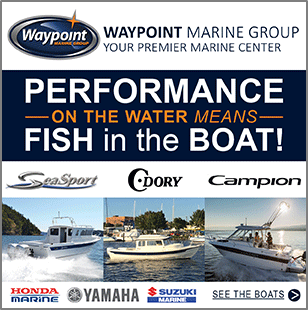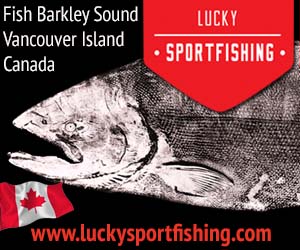Tillamook Bay
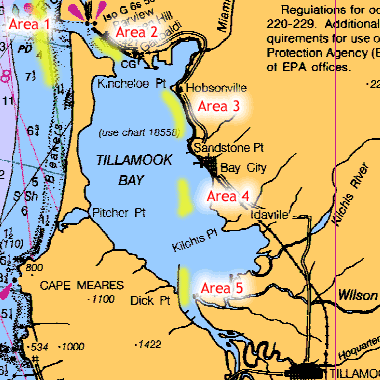 Tillamook Bay: the words conjure visions of big sleds boating huge kings in this scenic, shallow bay. Two things set Tillamook Bay apart from other bays: The fact that it is the largest estuary on the coast, and the productivity of its tributaries: the Miami, Kilchis, Wilson, Trask and Tillamook. With fall Chinook runs often in excess of 30,000 spawners, Tillamook Bay is truly one of the best opportunities on the coast to boat a fifty-pounder. T-Bay can be effectively fished by a variety of methods. The surest way to learn, however, is to go with a pro. Brad Vanderzanden (bvanderzan@aol.com) has guided Tillamook for over six seasons, boating several fish over fifty pounds. This life-long Oregon resident alters his tactics to cope with the ever-changing conditions in the bay.
Tillamook Bay: the words conjure visions of big sleds boating huge kings in this scenic, shallow bay. Two things set Tillamook Bay apart from other bays: The fact that it is the largest estuary on the coast, and the productivity of its tributaries: the Miami, Kilchis, Wilson, Trask and Tillamook. With fall Chinook runs often in excess of 30,000 spawners, Tillamook Bay is truly one of the best opportunities on the coast to boat a fifty-pounder. T-Bay can be effectively fished by a variety of methods. The surest way to learn, however, is to go with a pro. Brad Vanderzanden (bvanderzan@aol.com) has guided Tillamook for over six seasons, boating several fish over fifty pounds. This life-long Oregon resident alters his tactics to cope with the ever-changing conditions in the bay.
Brads techniques include trolling Flatfish, spinners and cut-plug herring, but despite the changing terminal tackle the basic rig stays the same. Thirty-pound Sufix Hi-Vis mono mainline to a three-way swivel, 15 inch sinker drop and a 4-foot, forty pound leader. Brads sinker selection runs from 12oz balls used out at the jaws of the bay to 2oz mini-balls in the shallow channels at the head of the bay.
Tillamook Bay challenges the angler with a wide variety of conditions – ranging from open ocean fishing outside the jaws of the bay to narrow river channels sometimes no deeper than four feet! Regardless of your location in the bay you must always troll with the tide to cover more water and encounter more fish. Certain techniques will be more productive than others depending on your location. Lets look at each area and its associated technique in depth.
Area 1
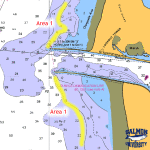 If the river flows are high, coloring up the bay and if the winds and sea conditions allow, give the open water a try. Outside the jaws of the bay you will be exposed to ocean swells. This constant up and down motion is tailor-made for fishing cut plugs. South of the jaws troll in a north/south direction depending on the tide and try to follow a depth contour. That is, start fishing in 15 to 20 feet of water and make a concerted effort to maintain that depth. If you are hooking or marking fish on your Lowrance sounder, stay at that depth. If not, try the 25 to 30-foot line and so on. North of the jaws your trolling path will have more curves and it will be tougher to maintain a given depth but the increased structure in this area will produce chinook so stay with it. Stagger the depths of your gear so that you’re covering the entire water column. To accomplish this and to reduce tangling, rods at the stern should have lighter weights than your rods pointing out the sides of the boat. Run a different length of line on each rod. For example: rods up front 6oz leads, 12 strips out (two-foot pulls), while the rods out back will be fishing 4oz leads at 20 pulls.
If the river flows are high, coloring up the bay and if the winds and sea conditions allow, give the open water a try. Outside the jaws of the bay you will be exposed to ocean swells. This constant up and down motion is tailor-made for fishing cut plugs. South of the jaws troll in a north/south direction depending on the tide and try to follow a depth contour. That is, start fishing in 15 to 20 feet of water and make a concerted effort to maintain that depth. If you are hooking or marking fish on your Lowrance sounder, stay at that depth. If not, try the 25 to 30-foot line and so on. North of the jaws your trolling path will have more curves and it will be tougher to maintain a given depth but the increased structure in this area will produce chinook so stay with it. Stagger the depths of your gear so that you’re covering the entire water column. To accomplish this and to reduce tangling, rods at the stern should have lighter weights than your rods pointing out the sides of the boat. Run a different length of line on each rod. For example: rods up front 6oz leads, 12 strips out (two-foot pulls), while the rods out back will be fishing 4oz leads at 20 pulls.
Area 2
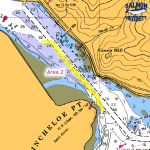 Think of this area as a salt-water “river” running from Painted Rock to Kincheloe Point. This “river” however has a rule… never troll against the current. Salmon generally face the tide so, to cover more water and keep your gear in their face… go with the flow. This is a good place to hit during the neap tides (periods of less tidal exchange) or on the tide change or slack water. The current can really rock through this channel and you’ll be surprised how much water you cover. On the flood, start your troll at Painted Rock and finish just past Kincheloe Point then pick up the gear and do it again. Reverse this pattern on the ebb and you’re in business. Cut-plugs are the top bait here but the sardine-wrapped Flatfish boys take their toll during the slack water.
Think of this area as a salt-water “river” running from Painted Rock to Kincheloe Point. This “river” however has a rule… never troll against the current. Salmon generally face the tide so, to cover more water and keep your gear in their face… go with the flow. This is a good place to hit during the neap tides (periods of less tidal exchange) or on the tide change or slack water. The current can really rock through this channel and you’ll be surprised how much water you cover. On the flood, start your troll at Painted Rock and finish just past Kincheloe Point then pick up the gear and do it again. Reverse this pattern on the ebb and you’re in business. Cut-plugs are the top bait here but the sardine-wrapped Flatfish boys take their toll during the slack water.
Area 3
 Hobsonville Pt. marks the north end of the area known to local fishermen as the “Ghost Hole”. The Ghost Hole also marks the beginning of the shallower portions of Tillamook Bay. Put away the big sinkers here. You’re looking at ten feet at Hobsonville Point and maybe fifteen when you get down to the pilings. Since current flow is reduced in this area, sardine-wrapped Flatfish and spinners see more action here. Again, go with flow and pay attention to your Lowrance sounder, the water shallows up very quickly around the Point.
Hobsonville Pt. marks the north end of the area known to local fishermen as the “Ghost Hole”. The Ghost Hole also marks the beginning of the shallower portions of Tillamook Bay. Put away the big sinkers here. You’re looking at ten feet at Hobsonville Point and maybe fifteen when you get down to the pilings. Since current flow is reduced in this area, sardine-wrapped Flatfish and spinners see more action here. Again, go with flow and pay attention to your Lowrance sounder, the water shallows up very quickly around the Point.
Area 4
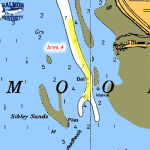 The south end of the “Ghost Hole” is also the end of the Bay City Channel. The channel ends in a “fork” and the “fork handle” is the area that we’re interested in here. This area is best fished on the ebb. As the low tide begins to dry up the shallow flats of the Bay, those chinook that have not committed to the river will run for cover in the deeper portions of the channel where you lucky Salmon University graduates will be there to greet them. We’re talking shallow water here so it’s light leads and spinner or cut plug time. This is also a great place to borrow a Wind River technique and slip the kings blaze orange magnum Fatfish 50 feet behind the boat with no weight. This is a very narrow channel that requires constant attention to boat placement and gear depth but do it right and you’ll end up with an ebb tide king or two.
The south end of the “Ghost Hole” is also the end of the Bay City Channel. The channel ends in a “fork” and the “fork handle” is the area that we’re interested in here. This area is best fished on the ebb. As the low tide begins to dry up the shallow flats of the Bay, those chinook that have not committed to the river will run for cover in the deeper portions of the channel where you lucky Salmon University graduates will be there to greet them. We’re talking shallow water here so it’s light leads and spinner or cut plug time. This is also a great place to borrow a Wind River technique and slip the kings blaze orange magnum Fatfish 50 feet behind the boat with no weight. This is a very narrow channel that requires constant attention to boat placement and gear depth but do it right and you’ll end up with an ebb tide king or two.
Area 5
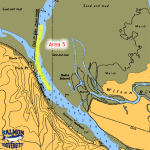 The Dick Point Dike is the place to be on the flood. Chinook will make their deepest ventures into the bay on the high tides. Many anglers are unaware of mature salmonid estuarine behavior. Suffice it to say that the maturing king will make several forays into the river mouth-only to return to the bay- before committing to the fresh water. Part of this repetitive migratory activity is due to osmotic mitigation or “getting used to” fresh water after spending the majority of his life in the brine. The other reason might be to become accustomed to the confines of riverine habitat, which probably seem small compared to the recently departed oceanic pastures. At any rate, get up to the head of Tillamook Bay on the flood. Again working with the tide, start just north of where the back channel meets the dyke and work down to the pilings paying particular attention to where the kings are rolling. Dick Pt. is the home of the infamous “slack line bite”. Quite often Brad has his clients hold their rods so they can set the hook when the king grabs the spinner and swims along with the boat. If you do get a “slacker” set the hook hard and hold on. Quite often, due the shallow water up in the bay the king will come to the surface, shake his head, and go off on a “shark attack” run, cutting the surface with his dorsal fin…and that’s classic Tillamook Bay.
The Dick Point Dike is the place to be on the flood. Chinook will make their deepest ventures into the bay on the high tides. Many anglers are unaware of mature salmonid estuarine behavior. Suffice it to say that the maturing king will make several forays into the river mouth-only to return to the bay- before committing to the fresh water. Part of this repetitive migratory activity is due to osmotic mitigation or “getting used to” fresh water after spending the majority of his life in the brine. The other reason might be to become accustomed to the confines of riverine habitat, which probably seem small compared to the recently departed oceanic pastures. At any rate, get up to the head of Tillamook Bay on the flood. Again working with the tide, start just north of where the back channel meets the dyke and work down to the pilings paying particular attention to where the kings are rolling. Dick Pt. is the home of the infamous “slack line bite”. Quite often Brad has his clients hold their rods so they can set the hook when the king grabs the spinner and swims along with the boat. If you do get a “slacker” set the hook hard and hold on. Quite often, due the shallow water up in the bay the king will come to the surface, shake his head, and go off on a “shark attack” run, cutting the surface with his dorsal fin…and that’s classic Tillamook Bay.
How to Fish for Salmon | How to Catch Salmon | How to Fish for Tuna | How to Catch Tuna | How to Fish for Halibut | How to Catch Halibut


